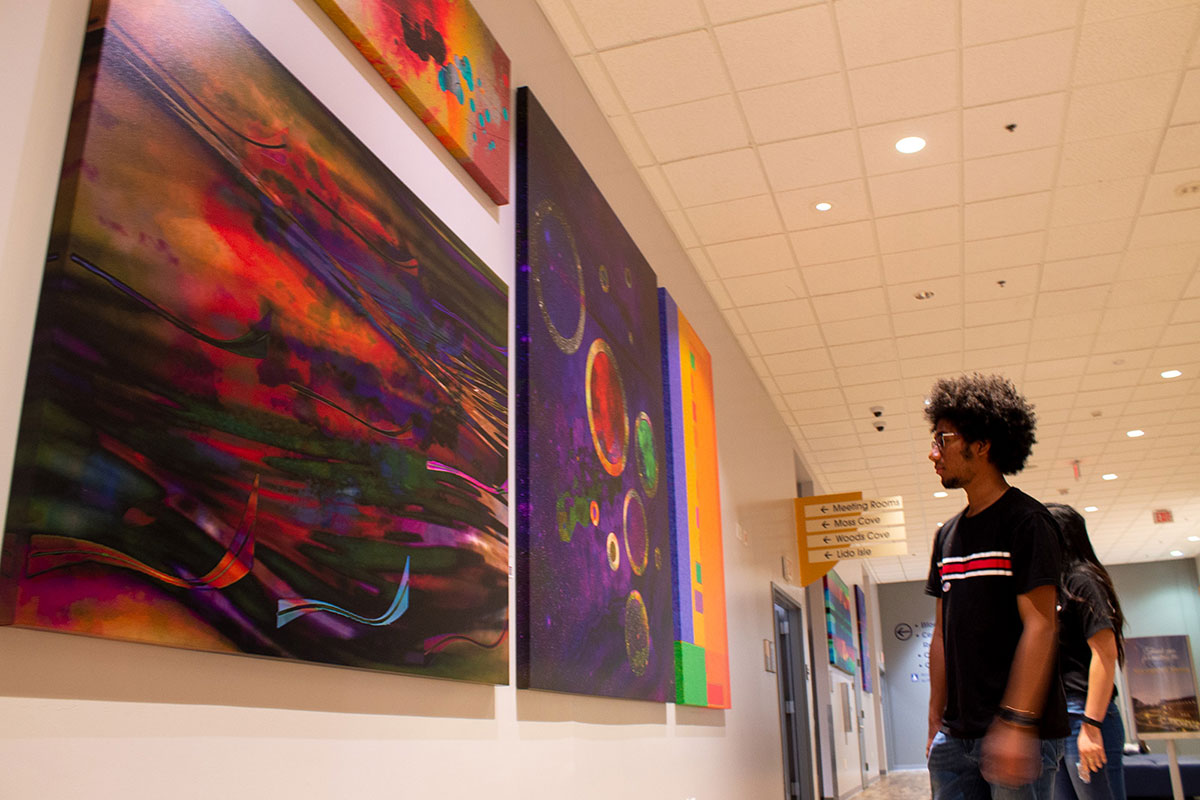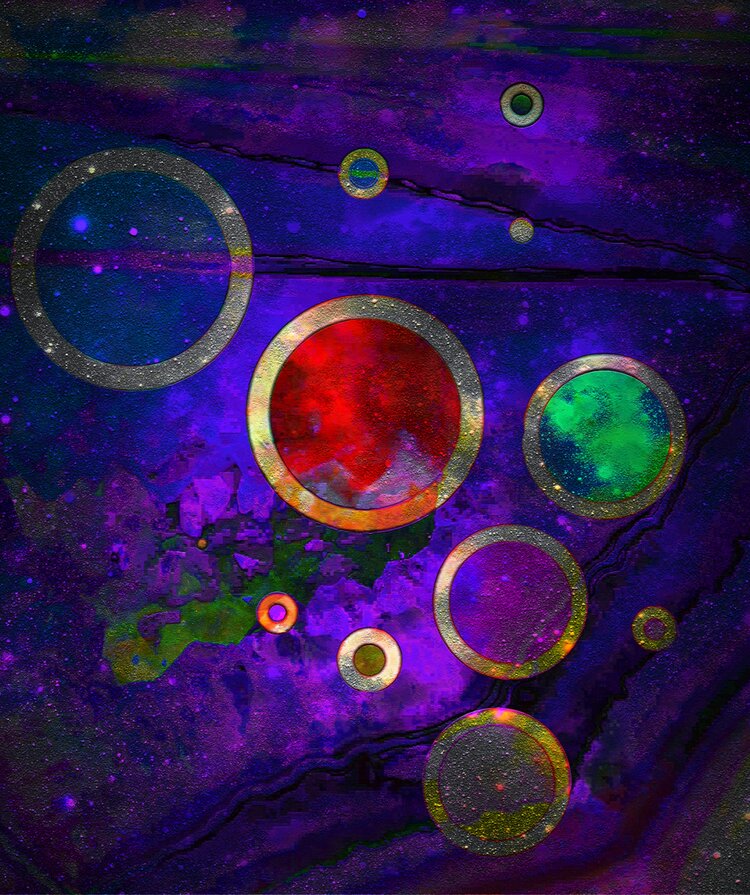Stories
Inspired Art on Display in Ballroom Lobby

Students examine the tall canvas prints of the Environmental Graphiti artwork. On display in the Pacific Ballroom lobby.
Posted on April 3, 2020
by Nel Tristan
The Student Center installed new thought-provoking canvas digital reproductions outside the Pacific Ballroom.
You may have noticed them, sitting on previously empty walls. Considering they stand 10 feet tall, towering over the space, they are hard to miss. You may have noticed they’re not the typical UCI brand, like the hallway lined with shots of our favorite anteater.
The paintings are abstract, and you’re not quite sure what you’re looking at.
Maybe it’s a whale gliding across its navy and gold canvas. Smokestacks rising over violet smog into the blazing sky. Space was a pretty common assumption. A few people saw oily rivers and spilled gasoline, which is a little closer to the mark.
Maybe you see it immediately. That’s a graph, and you are right. You are looking at a graph. You are looking at carbon emissions. You are looking at fossil fuels and climate refugees and influences on warming.
You are looking at climate change and the impact it has across the globe.
Any confusion you feel toward the image is entirely intentional. “Environmental Graphiti—The Art of Climate Change” was conceived in 2014 by artist Alisa Singer, with the intent of raising awareness about the threat climate change poses to the environment. Singer transforms infographics and statistics into vibrant works of digital art. The pieces are designed to make you look twice, so you begin to see the patterns in the flurry of colors and shapes.
“When you first see an exhibit of the paintings, they appear abstract,” Singer says. “But each piece is displayed with a wall plaque that shows the graphic data from which the piece was derived, together with a short summary of the key message. Once people realize the art comes from the graph, they begin a back-and-forth process of looking for the outlines of the graph in the art and figuring out what the graph means. By this process, the viewers find themselves engaged in the science, as well as the art.”
Singer’s intention is increase audience engagement with her artwork and raise awareness through its eye-catching visuals, so vibrant you have no choice but to stop and look. She brings issues regarding climate change to light, in a manner which is visually interesting and more easily accessible to the public. Looking translates directly to engaging, which is the first step to considering a more sustainable lifestyle.
“I found the general public’s lack of alarm about the compelling facts regarding climate changes somewhat bewildering. It seemed likely that many people were confused or intimidated by the charts and graphs depicting the science, and it occurred to me that art could become the vehicle for delivering the facts in a more user-friendly way,” Singer says. “Each piece in the collection of over 80 pieces uses as its blueprint—a chart, graph, map, word or number relating to a key fact about climate change.”
From changing temperatures, to the projected rising of sea levels, Singer’s art covers a broad range of relevant topics. The pieces are all constructed digitally, allowing Singer a wider distribution for her artwork, and to enable Singer more freedom to build off the graphs she chooses as a base. “Each piece must stand independently from an aesthetic perspective, but can be morphed back into the original graph to demonstrate that it was derived from the data. The choice of colors and textures is very serendipitous – happy accidents and all that.”
Though certain organizations on campus were already aware of her work, Singer did not become a main feature of the Student Center hallways until Marketing Manager Brian Petyo happened across her piece, “Current and Projected Arctic Ice Conditions” while passing through the Sustainability Resource Center. Petyo became enamored with her unique style and the message embedded in the colorful pixel strata. He quickly worked to get into contact with Singer. He knew that he wanted to put her artwork on the walls, and he wanted the pieces blown up to epic proportions. “We upsized this art,” says Petyo. “It’s in your face. It’s bold, it’s beautiful, and it’s an aesthetic for the science.”
The motives behind Singer’s collection aligns with the university’s goals for sustainability and environmental awareness. Hanging her artwork on the walls is yet another way of entering the conversation. Nothing says more than the 10 feet tall canvases, which the in-house maintenance team carried through the hallways.
“We’re shaping the space,” Petyo continues. “We’re shaping behaviors and we’re shaping the conversation around climate change. We have to put our values on the wall. Maybe you’re not researching sustainability, and maybe you don’t have a way to actually clean the oceans. But no matter what you’re doing, or who you are, or what your product is, you will find a way to be creative and help. Maybe, it’s just bringing awareness to a big problem. There is a way to join.”
Singer asks you to contemplate matters which may be at the forefront of your mind, or maybe the back. By breathing life into the statistics, offering art that is stunning and interesting, she encourages her audience to be more aware of the impacts of climate change. Whether you’re intimidated by the statistics or disinterested in the details, Singer ensures you have no choice but to stop and look at the numbers in the colors.




